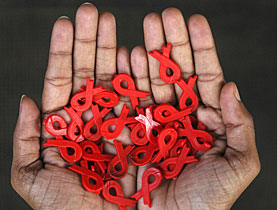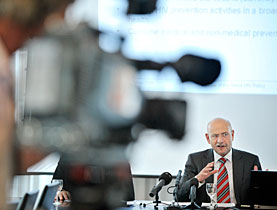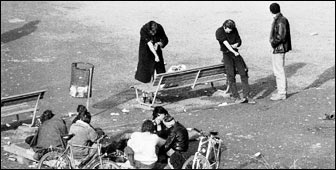Living with HIV as a constant companion

At 33.4 million, there are more people living with HIV than ever before, mainly because antiretroviral therapy is prolonging lives.
On World Aids Day, swissinfo.ch looks at the life of one Zurich woman who tested HIV positive in 1986.
“At the time Aids was a new disease. We knew that most Aids sufferers died within two to three years.” Françoise Dupont (not her real name) recalls.
UNAids has reported a drop in new infections of 17 per cent in the past eight years, further confirmation that the epidemic is past its peak. Although experts warn that this is far from an all-clear the vast majority of infected people in Africa still have no access to therapy.
Dupont lived through the early days of absolute ignorance about HIV/Aids, suffered from the effects of unsuitable medication and finally went on to experience a gradual stabilisation of her condition.
The 49-year-old works three days a week in a daycare centre with children of different ages. “I can’t work any more than that but I am glad that this is still possible,” she told swissinfo.ch.
A total shock
She was most likely infected with HIV in the 1980s at the AJZ (autonomous youth centre) she used to frequent. They were pretty wild years, affected by the youth movement in Zurich where she grew up.
“After I developed various symptoms I did an Aids test in 1986, as a 26 year old. The result was clear: HIV positive. It was a total shock, I found myself in a traumatised state. You don’t know what you are doing any more because you just can’t take it in.”
“Aids was a new disease then, seen as the disease of gay men,” Dupont remembers.
“It was known that most Aids sufferers died within two or three years. There was no more information about it at that time. You were effectively staring death in the face. Knowledge about Aids in 1986 was at a totally different level compared with today.”
How to go on?
That was the question that Dupont had to figure out next. “The fighting side of me allowed me to say: I will not die of Aids, I want to live, to carry on.”
“It was something I had to keep saying to myself especially at times when I felt weak. Very often I woke at night, totally drenched in sweat. I felt increasing tiredness, I had hardly any energy, I began to look after myself.
“On the other hand I wanted to break out of this and widen my horizons.”
Over the next few years she tried out lots of different therapies, especially with complementary medicine, to support her immune system. But she never stopped working.
Friends?
“Back in 1986, the first question was who would I tell about my illness. My partner at the time, who was a doctor, simply left because he was scared. That’s how everyone who was close to me reacted!”
And so it became clear to Dupont how tricky it was to reveal her illness, “because people were simply afraid of Aids”. That’s why the young woman sought out a circle of friends carefully.
“It was clear to me that I needed people around me who knew that I was HIV positive. A network that knew it and could cope with it, so that I would not be isolated with my problem.”
Dupont sought out like-minded people. She approached the recently created Swiss Aids Federation, which gave her contact addresses. From this grew the first self-help group in German-speaking Switzerland.
“We only lasted about two years because the people in the group started dying one after the other.”
When the first person in the group became very ill, the other members all felt fear and panic. The thought was: If you can die then so could I.
It was a crazy time, according to Dupont. “I was afraid. In the media it was still being discussed whether Aids sufferers should be sent to an island. We regularly got drunk at our meetings and told each other the worst Aids jokes with suppressed cynicism and fear.
Rough treatment
In the 1990s, apart from AZT, a medicine that came from cancer therapy, there was no specific Aids therapy.
“People were poisoned with AZT, as was officially admitted later. For several years, HIV positive patients were treated with a much too high AZT dose. Those taking the drug all looked the same, as if they came from a concentration camp. It was a bad time.”
Today the drugs available are much better and thanks to that far fewer people die of the disease. “There was a time we often had to go to funerals.”
Dupont was always very critical towards conventional medicine and drugs, “but if I wasn’t well for three or four weeks, naturally I took them again.”
But a life on medication is no joke, she says. You have to learn to live with the side effects. It’s not talked about enough and that means “a whole spectrum of states of anxiety”.
Added to that is the constant secrecy. “When you’re out, always having to have a little bottle with you and going to the toilet quickly and secretly to take the medication.”
Life worth living
Discrimination against HIV positive people is still an issue today. Many sufferers therefore live a double life, Dupont says.
“They talk about it at Aids conferences, why we don’t admit our situation, why there are hardly any people who point to themselves and say this is my name, this is my face and I am HIV positive.”
That has something to do with the medication. “The drugs have allowed us to be ‘normal’ again, but the question remains – at what price?”
Despite it all the 49-year-old HIV-positive woman says her life is absolutely worth living. “Even if I don’t know if I will see 50, 60 or 70, I live more intensively because my life is simply not guaranteed.”
Jean-Michel Berthoud, swissinfo.ch (translated from German by Clare O’Dea)
In Switzerland more than 30,000 HIV positive test results have been recorded. Some 25,000 people are living with HIV and Aids in the country.
From the beginning of the epidemic to the end of December 2008 about 8,800 Aids cases have been recorded and 5,782 people have died of Aids related illnesses.
In 2008 778 new positive HIV test results were recorded. Of these 26 per cent were women.
Of all infections, around 45 per cent come from heterosexual contact.
An estimated 33.4 million people live with HIV/Aids.
In 2008 2.7 million people were newly-infected with the disease.
Two million people died of Aids in 2008.
About 28 million people have died of Aids-related illnesses. Almost two thirds of the global total of people with HIV/Aids, live in sub-Saharan Africa (22.5 million).
At least four in five of those with HIV/Aids and who need HIV therapy have no access to medical treatment.
(source: UNAIDS World Aids Report 2009)
On World Aids Day, December 1, the Swiss Aids Federation is calling for solidarity with HIV-positive people. Two more infected people join the number of 25,000 in Switzerland every day.
Thanks to great advances in medicine, HIV/Aids is no longer a terminal illness. Yet almost 25 years after the Swiss Aids Federation was founded, HIV-positive people suffer prejudice and discrimination at work or in their social environment.
Many sufferers live a double life and hardly dare to tell the people around them about their condition, according to the federation. The normalisation of HIV infection through the availability of medication should finally be followed by normalisation in society, it says.

In compliance with the JTI standards
More: SWI swissinfo.ch certified by the Journalism Trust Initiative









You can find an overview of ongoing debates with our journalists here . Please join us!
If you want to start a conversation about a topic raised in this article or want to report factual errors, email us at english@swissinfo.ch.